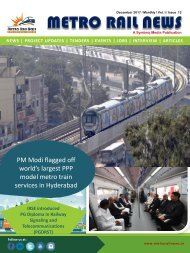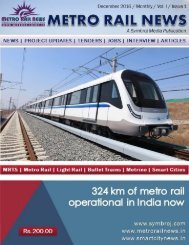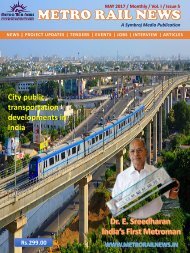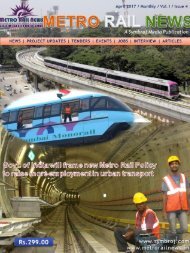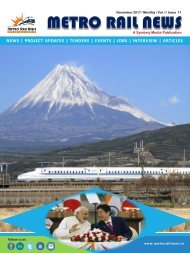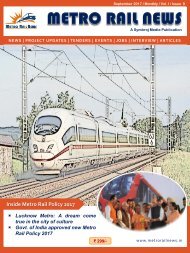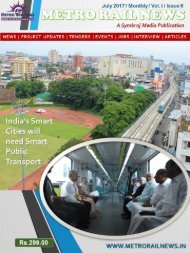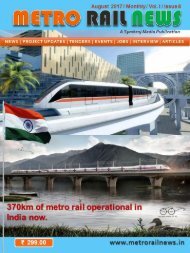Metro Rail News October 2017
October Edition 2017. Owned and published by Symbroj Media Pvt. Ltd., New Delhi, India
October Edition 2017. Owned and published by Symbroj Media Pvt. Ltd., New Delhi, India
Create successful ePaper yourself
Turn your PDF publications into a flip-book with our unique Google optimized e-Paper software.
A recent IIM Ahmedabad report claimed that<br />
the bullet train will have to ferry around 1.18<br />
lakh passengers per day or do 100 trips a day<br />
between Ahmedabad and Mumbai to make it<br />
financially viable. Your views?<br />
Financial viability is something which different<br />
people take in different prospects. We should be<br />
able to run the system on our own without<br />
seeking any grant from any source. Another<br />
aspect of viability is from the economic<br />
perspective. Infrastructure projects should not<br />
be looked purely from the profitability point of<br />
view. In any infrastructure project, it is very<br />
difficult to earn profits in its initial phase.<br />
Currently, it takes eight hours to reach Mumbai<br />
from Ahmedabad. If people cover this distance<br />
within two hours, they can utilise the remaining<br />
six hours for some productive work.<br />
People all over the world resisted the first-time<br />
projects and as soon as they start using them, it<br />
becomes a necessity.<br />
The project will definitely generate operating<br />
profit and would not need money to run the<br />
system on yearly basis, but it will not be able to<br />
support the depreciation. It will be able to<br />
support the 0.1% interest on loan and the<br />
operating cost.<br />
What plans do you have for getting<br />
uninterrupted electricity supply for the bullet<br />
train?<br />
Getting uninterrupted electricity supply for the<br />
high-speed network is another challenge. A study<br />
is being conducted by the NHSRCL to understand<br />
the best way of tapping electricity. There are<br />
five-six power distributers with whom the talks<br />
are going on. We will have the figures of the<br />
exact amount of electricity required for the highspeed<br />
train in the next three months. Once the<br />
statistics are with us, we will accordingly<br />
approach the distribution companies. The<br />
Shinkansen system requires the least power<br />
consumption per seat compared with any other<br />
high-speed trains globally.<br />
There are reports that Maharashtra has some<br />
reservations on the proposed high-speed station at<br />
Bandra Kurla Complex.<br />
It’s not a bone of contention between the<br />
Maharashtra government and the NHSRCL. The BKC<br />
in Mumbai has two sides: one is an exhibition ground<br />
and the other is the G block. The Maharashtra<br />
government has asked us to examine the G block first<br />
and if it suits our requirement, the NHSRCL will build<br />
the high-speed station there; otherwise the<br />
exhibition ground area would be chosen.<br />
Investigations are going on to find a suitable location<br />
in BKC.<br />
According to media reports, the Shinkansen<br />
technology of the bullet train was a flop in Taiwan.<br />
What makes you sure that it will be a hit in India?<br />
The loan interest and depreciation cost were the<br />
major reasons behind the poor show of the bullet<br />
train in Taiwan. It is not that people are not accepting<br />
the bullet train in Taiwan. I would not say the<br />
Shinkansen system has failed in Taiwan. Ridership is<br />
increasing gradually. The bullet train started in 2007-<br />
08 in Taiwan and at that time the ridership was<br />
around 40,000 and by 2014 it went up to 1.40 lakh<br />
per day. The air traffic in the same sector is reducing<br />
in Taiwan.<br />
The project came up in Taiwan on public-private<br />
partnership (PPP) basis, which is not the case with<br />
India. Taiwan’s loan was a commercial loan and<br />
India’s interest on the Japanese loan is very nominal.<br />
Besides, India will have to pay interest 15 years after<br />
receiving the loan, which gives us enough time. If<br />
Taiwan takes out depreciation, even now its bullet<br />
train will become profitable.<br />
If the bullet train was not acceptable to Taiwanese<br />
people, how come the traffic increased? Air traffic in<br />
Taiwan in a certain section has almost come down to<br />
half.<br />
Many believe that the loan given by Japan to India<br />
is not a soft loan. Please elaborate.<br />
In all likelihood, if Japanese Yen becomes strong<br />
© METRO RAIL NEWS | OCTOBER <strong>2017</strong> | WWW.METRORAILNEWS.IN<br />
45






